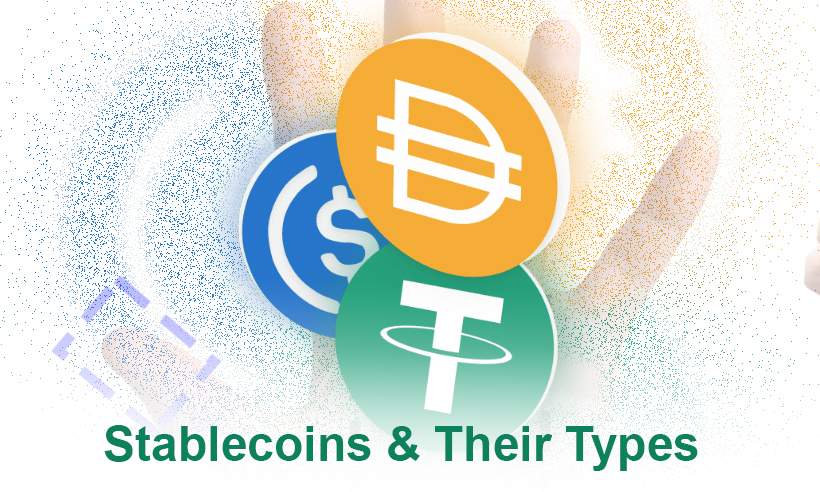
Your Handy Guide To Stablecoins And Their Types

Cryptocurrencies were officially introduced in the year 2008 and from that time, we are observing them growing. These virtual assets have completely revolutionized the traditional payment system that involves the third party controlling the transactions. If this third-party is eliminated, we will reach a completely decentralized system.
This is what cryptos brought to us. Now, these cryptos are quite volatile in nature. People fear them all the time, which led to the introduction of stablecoins that are secure in many ways. Below is a guide to stablecoins that will let you understand what they are together with their features.
Guide To Stablecoins
Stablecoins or stable cryptocurrencies are the virtual coins that are backed by physical assets we use in today’s time. These physical assets can be a bar of gold or traditional currencies like dollars, yen, rupees, etc. The country that introduces stablecoins uses its own fiat to give some security to the cryptos. When stablecoins are pegged with fiats, they become a part of the economy and follow some rules and regulations applied to fiats.
Now, this somewhat brings centralization in cryptos as they will be combined to fiats. Still, stablecoins are produced so that both the crypto world and the actual world benefit from this. These coins are quite secure and they perform better than cryptos that are not stable. Rest abilities are similar to that of original cryptos, like P2P transactions, better cryptographic encryption, and hashing.
We all know that cryptos are volatile. People love to trade with cryptos just because they love volatility. However, with stablecoins, you must forget that. They are now cryptos that will operate just like traditional fiats. Thus, you will have less profitability while trading and investing in them. As of now, there exist over 200 stablecoins in the market. A majority of them are yet in a line of research and development and others are fully operational.
Research and development on these cryptos are essential so that they do not cause any problem when pegged with fiats. On the other hand, if they cause problems, countries will face financial loss in the future. The market capitalization of these stable cryptos has presently reached billions of dollars, which is less than that of the popular cryptos like Bitcoin, Ethereum. This is because stable coins are under the control of authorities managing fiats.
Types Of Stable Cryptocurrencies
1. Stable Cryptos Collateralized By Fiats
This is a category of stablecoins that are backed by fiats. The ratio between the crypto and the fiat always remains 1:1. A stablecoin is backed by one fiat in this category. The two most common fiats in this category are TrueUSD and Tether.
2. Stable Cryptos Collateralized By Commodity
Now cryptos can be pegged by commodities because commodities can also be put to trade. These commodities can be precious metals like gold, silver, platinum, etc. The two most common fiats in this category are HelloGold and Digix.
3. Stable Cryptos Collateralized By Cryptos
This category of cryptos is pegged by popular virtual assets. The idea is to bring volatility in stablecoins, which is against the principle lying behind stablecoins. The ratio is again 1:1 in this category of cryptos. Still, it can be changed to more than one crypto.
4. Stable Cryptos That Are Not Collateralized
Stablecoins may appear with no collateralization. This set of virtual assets is not backed by anything but they operate on automated, complex algorithms that initiate trading to maintain the price fluctuations. These fluctuations bring stability here.
Are Stablecoins Growing?
Earlier they were not, but in 2020, stable cryptos have shown tremendous growth. Within a half year, the market capitalization of stable cryptos reached 12 billion dollars from 6 billion dollars, which they took five years to reach. A major fiat that is backing these digital assets is the US dollar. Just after stablecoins gained popularity, they are giving way to CBDCs, the digital currencies that are backed by central banks. The central banks are researching their own coins to boost their economy. CBDCs have a future as they will have fewer problems on gaining adoption within countries.
Conclusion
In this guide to stablecoins, I have explained about stablecoins and their features. The list of stable cryptocurrency contains more than 200 coins and more and more of them are getting included. You will not get immense profits while trading with them because they are less volatile. However, you will also not lose more money as they are backed by reliable, traditional assets.
When it comes to their adoption, they face fewer problems than popular cryptos as they are under the guidance of governments. Talking of CBDCs, they are the future of stablecoins and are under the control of central banks. In the future, some stablecoins will be replaced by CBDCs and they will operate just next to fiats.
















